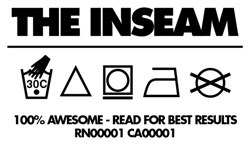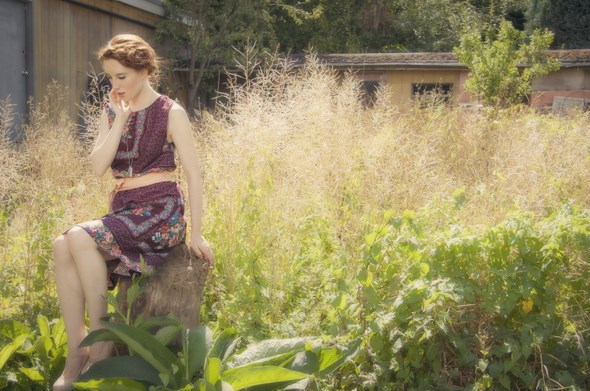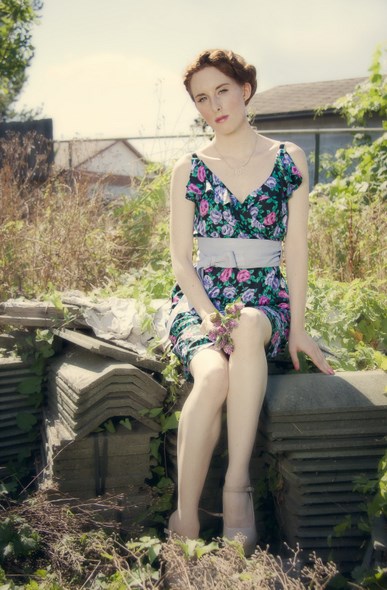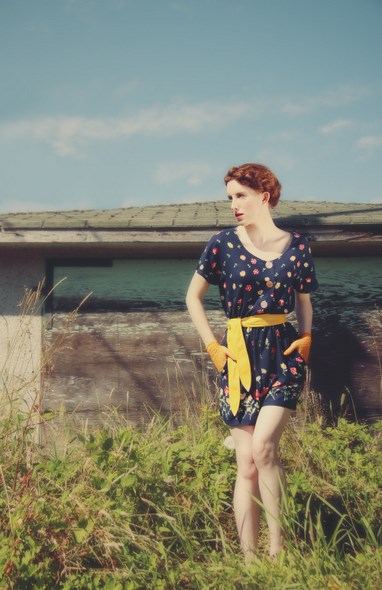 |
Vancouver is home to a thriving fashion industry made up of individuals committed to its growth and success. Get to know these personalities in The Inseam and discover what makes the Vancouver Fashion scene so awesome. Every month, The Inseam’s Eco Edition focuses on the innovators that shape the green movement in local fashion. |
Photo courtesy of Adhesif Clothing
Melissa Ferreira, the designer behind Adhesif Clothing is quite possibly Vancouver’s matriarch of ecofashion. For the past 13 years, Melissa has used almost exclusively vintage and used materials to create one-of-a-kind garments of her own design. Honing her sewing and design skills over time, Melissa has also strived to achieve the most sustainable production levels she can, with second-hand textiles and virtually zero waste.
Jessica McIlroy: Tell me how you got started.
Melissa Ferreira: My mom is a seamstress, and I grew up with her sewing at the kitchen table. I used to go to the factory she worked in when I had professional days at school. That fused in with the fact that we went to thrift stores my whole life. I’ve always had a love for vintage fashion and eventually found myself working as a vintage clothing buyer right out of high school.
JM: Did you make your own clothes in your teens?
MF: I was mostly redesigning and restyling things. My sewing ability was pretty terrible when I was a teenager. I was always more interested in the design aspect than garment construction. But my mom was like, “Look I can’t always be making stuff for you, you need to learn how to sew”. Eventually I sat down and challenged myself to conquer industrial sewing machines. It was a more difficult way to sew but it makes you a better seamstress.
Photo courtesy of Adhesif Clothing
JM: Where did you grow up?
MF: In Montreal, I moved here in 1994. I had started taking clothing home and refurbishing it, from the vintage shop, and doing more redesigning then making things from scratch. Design then came later. I found that it was a difficult thing to market, but I find it’s what still brings me most of my joy. Then the collection starting coming to fruition, and I realised that in order to sell things that are one-of-a-kind there had to be some kind of consistency. I started creating my own original designs and just using old fabric in place of new fabric. That’s how they maintained the original quality.
JM: What made you decide to form a brand and go in that direction?
MF: I had a ‘eureka’ moment. I was working as a manager for a vintage clothing boutique. I was the buyer, the manager, everything for this boutique, and the owner would let me take whatever wasn’t sellable and use it for my own creations. I delved into the realm of vintage knitwear, recycling sweaters, hand dying them and silk-screening them; trying to take that to a certain level. And it took me a whole month to make five cardigans.
I took them into Dream in Gastown and that same morning a woman came in and basically bought them all, and it had taken me a month to make them. I had no idea what to price them at and severely underpriced myself. They told me bring more, but it took me forever to make those. They were gone, and that was amasing, but I was like, how am I going to make more. So that was my ‘eureka’ moment.
No one at the time was really doing anything with recycled sweaters. So I took the ball and ran with it, doing a lot of winter designs, heavier pieces like coats and sweaters. I got laid off from the vintage shop and I took that opportunity to get into a self-employment program. For that whole year I had the time to get my business started and talk to anyone who would listen to me. I did a lot of shows, a lot of pounding the pavement.
JM: I assume you then got to know a lot of the retailers and designers in Vancouver.
MF: In that one year I went to anyone who would give me the time of day.
Photo courtesy of Adhesif Clothing
JM: How was the response?
MF: No matter how cool your product is, it is always going to be a challenge. You have nothing to go one. I severely undercharged myself just to get out there. Starting up as a designer is hard, to figure out what your price point is and what you can live with.
JM: There is only a certain amount people will pay, but you need to make a living.
MF: There is a threshold. Every city has its own threshold and you need to know what it is. If you were in New York it would be a completely different ballgame. But it’s also more expensive to run something there and there is more competition. You’ve got to make the best with what you’ve got and I feel that’s what I’ve done in the past ten years with the label.
JM: How long has the shop been open?
MF: Going into four years now.
JM: What made you open a retail shop?
MF: It was just one of those things where the opportunity for the space came up and I knew I had to take it. I mentioned it to the woman who owns the shop next door, and this space came open. What sold me was the huge studio space. It’s hard to find the joint studio and retail space in Vancouver.
JM: Did you gradually find the other designers you carry or know from the beginning?
MF: I knew right away. People also approached me and I knew who was a great fit. We wanted to present designers with a sustainable mind frame. It doesn’t get more sustainable than your own backyard and the forty other designers I have are from Vancouver, other than one from Montreal who uses recycled leather. I’m not limited to local, but I’d like to keep it that way for as long as possible. Most of the designers are using found objects, sustainable materials and recycled elements and I’ve found them from doing so many shows over the years. That’s the fun part, working with all the other people that make it feel like a community.
JM: Are you doing seasonal collections with Adhesif?
MF: Yes, we do a collection every six months, Spring/Summer and Fall/Winter. Each collection has 8 to 16 original designs. The new Fall/Winter collection photo shoot is this coming weekend and for the first time we’ll have menswear, which is exciting.
JM: Do you have seamstresses that work with you?
MF: Everything starts and ends with me.
JM: Tell me about Nifty for Fifty.
MF: Nifty for Fifty is my own event I organise each year. It started off as a glorified garage sale really. I’m always finding materials and coming up with prototypes and I needed to make space, so I thought I’m going to start this event. Almost like a giving back to my clients, a Boxing Day sales event in April. It started off smaller, with 8-10 designers, but the response was overwhelming. More and more designers wanted to come in and now there are 31 vendors and 20 I had to turn down.
JM: Was the concept of being under $50 there from the beginning?
MF: Yes, it was actually $30 but people thought it was too low. So $50 was a good number. This year there is an incredible line up of Vancouver’s local designers.
You can find Melissa’s own line, Adhesif Clothing, at the Adhesif Boutique at 2202 Main Street, along with other fantastic local designers. The next Nifty for Fifty will be April 14th at the Heritage Hall.





